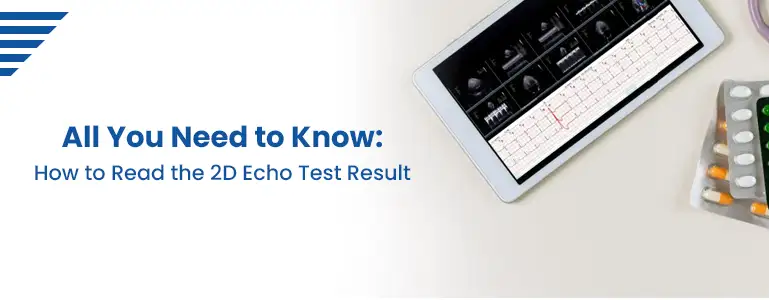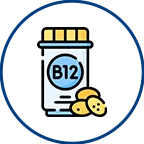All You Need to Know: How to Read the 2D Echo Test Result

A 2D echocardiogram, often called a 2D Echo, is a non-invasive medical test that produces precise pictures of the heart's anatomy and operation using ultrasound technology. It is essential for identifying and keeping track of different cardiac problems. Both people and healthcare professionals must be able to read the findings of a 2D Echo. In this blog post, we'll dissect the 2D echo test report and explain how to understand them.
Components of a 2D Echo Test Result
Patient Information: The top of the report typically includes essential patient details, such as name, age, gender, and the test date. Ensure that this information is accurate.
Image Views: The report will include several images or "views" of the heart. These views may consist of parasternal, apical, subcostal, and suprasternal. Each view provides a different perspective of the heart and its chambers.
Ejection Fraction (EF): The EF is a critical measure of the heart's pumping efficiency. It is expressed as a percentage and indicates how well the heart can pump blood. Usually, an EF falls between 50% and 70%.
Valve Function: The 2D Echo assesses the function of heart valves, including the mitral, aortic, tricuspid, and pulmonary valves. The report will note whether the valves are functioning normally or if there is regurgitation (leakage) or stenosis (narrowing).
Chamber Sizes: The measurements of the heart's chambers are recorded, including the left ventricle, right ventricle, left atrium, and right atrium. Enlargement of these chambers may indicate certain heart conditions.
Wall Motion Abnormalities: The report will indicate if there are any areas of the heart with abnormal wall motion. This could suggest heart muscle damage or ischemia (lack of blood flow).
Pericardium: The cavity that encircles the heart is called the pericardium. If there are any pericardial effusions (accumulations of fluid around the heart), which might be an indication of inflammation or other diseases, the report might highlight them.
Home Sample Collection
Interpreting the Results:
EF Percentage: Pay close attention to the ejection fraction percentage. A lower EF may suggest heart dysfunction, while a normal EF is a positive sign.
Valve Function: Check for any mention of valve abnormalities. Valve regurgitation or stenosis may require further evaluation and treatment.
Chamber Sizes: Compare the measurements of the heart's chambers to the normal ranges. Enlargement can be indicative of certain heart diseases.
Wall Motion: Note if there are any areas of abnormal wall motion. Abnormalities may suggest heart muscle problems.
Pericardium: If pericardial effusion is mentioned, discuss this with your healthcare provider, as it can be associated with various conditions.
Conclusion:
The 2D Echo test, also known as 2D echocardiography, is a crucial tool for the diagnosis of cardiac conditions. The echocardiography report is essential for making treatment decisions and diagnosing multiple kinds of cardiac conditions. In that case, reviewing the results with a qualified healthcare professional is recommended for further treatment.
Frequently Asked Questions
What is a 2D Echo test, and why is it performed?
A 2D Echo test, short for a two-dimensional echocardiogram, is a medical imaging procedure that uses ultrasound to create heart images. It is committed to assessing the heart's structure and detecting various heart conditions, including valve problems, heart muscle issues, and congenital heart defects.
How long does a 2D Echo test take, and is it painful?
A typical 2D Echo test takes about 30 to 60 minutes and is painless. A transducer, a piece of portable medical equipment, will be used by a technician to photograph the heart while coating the chest with a hydrogel.
How to read 2d echo test report?
The 2D echo test report involves examining the demographics of the patient, study details, echocardiographic results (chamber dimensions, valve function, and LV function), and implications. Seek advice from a healthcare professional for further assistance.
How much does a 2d echo test cost ?
The 2D echo test price in Hyderabad varies based on a number of variables, including insurance coverage, location, and healthcare provider. On average, the cost varies between INR 600 - INR 4,500.
For more information
Please click here to know the 2D echo test price
Are any risks or side effects associated with a 2D Echo test?
A 2D Echo is generally a safe and non-invasive procedure with minimal risks. Unlike other imaging tests, there are no known side effects, and it does not involve exposure to ionizing radiation.
What should I do if my 2D Echo test results show abnormalities?
If your test results reveal abnormalities, it's essential to consult a cardiologist or healthcare provider. They will discuss the findings with you, provide a diagnosis, and recommend appropriate treatment or further tests if necessary.
Can a 2D Echo detect all heart conditions?
While a 2D Echo is a valuable diagnostic tool, it may not see every heart condition. Some states may require additional tests, such as a stress echocardiogram, cardiac MRI, or coronary angiography, for a comprehensive evaluation.
Can children undergo a 2D Echo test, and is the procedure the same for them?
Yes, children can experience a pediatric 2D Echo. The process is similar to that for adults but may be tailored to accommodate a child's size and cooperation level. It is commonly used to assess congenital heart defects in children.
Are there any special preparations required before a 2D Echo test?
No unique trials are typically needed for a standard 2D Echo. However, if any particular precautions are necessary for your test, your healthcare professional could provide further instructions.
Can a 2D Echo be repeated, and if so, how often?
A 2D Echo can be repeated to monitor heart conditions or assess changes over time. The frequency of repeat tests will depend on your specific medical situation and your healthcare provider's recommendations.
Book Your Slot
Our Locations Near You in Hyderabad
3KM from Banjara Hills
1.9KM from Yusufguda
3KM from Madhura Nagar
5KM from Shaikpet
Profiles
- Cardiac Risk Profile
- Pituitary marker Profile
- Rheumatoid Arthritis Profile
- Dengue Fever Panel
- Lung Cancer Panel 1 Complete Molecular
- Gastroenteritis Screening Panel
- Thyroid Profile (T3,T4,TSH), Serum
- Pancreatic Marker Profile
- STD profile
- Androgen Profile
- Lipid Profile, Serum
- Pancreatic(acute)Profile
- PCOD Profile
Radiology
Pathology Tests
- Glucose Fasting (FBS),Sodium Fluoride Plasma
- Creatinine, Serum
- Glycosylated Hemoglobin (HbA1C)
- Vitamin B12 (Cyanocobalamin), Serum
- Thyroid Stimulating Hormone (TSH) Ultrasensitive, Serum
- Complete Urine Examination (CUE), Urine
- Liver Function Test (LFT),Serum
- Dengue (IgG & IgM), Serum
- Dengue Antigen (Ns1) Rapid, Serum
- C-Reactive Protein (CRP), Serum
- Widal (Slide Method), Serum
- Total IgE, Serum




